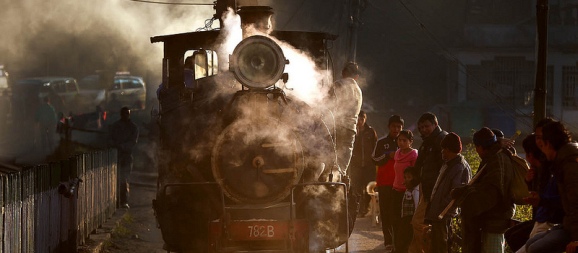DHR Wagons
Adapted from compilation by Terry Martin and David Churchill
 The DHR was conceived primarily as a freight railway. In earlier days, freight traffic provided a high proportion of its income. This required a large number of wagons, and the peak total of 606 was reached in the 1940s. After World War II, freight traffic declined steadily and finally ceased in the 1990s. Most freight wagons were soon scrapped, and only about 18 still exist - the exact number depending whether bodies without wheels are counted or not.
The DHR was conceived primarily as a freight railway. In earlier days, freight traffic provided a high proportion of its income. This required a large number of wagons, and the peak total of 606 was reached in the 1940s. After World War II, freight traffic declined steadily and finally ceased in the 1990s. Most freight wagons were soon scrapped, and only about 18 still exist - the exact number depending whether bodies without wheels are counted or not.
The early freight wagons were wooden bodied, but steel construction was soon found to be more suited to the conditions and all survivors have steel bodies and frames.


4-wheeled vans -
The archetypal DHR freight vehicle was a small 4-wheeled van with corrugated iron roof, a brake lever with step for brakesman across one end and usually painted in a red oxide colour. These are seen in large numbers in photographs from the 1920s through to the 1980s, but only 8 still remain, some in Ghum Museum and others at Tindharia. All are basically similar although with interesting variations. None are in regular use but some may be chartered for photographic purposes.
Bogie Flat Wagons
At 32 feet these are the longest vehicles on DHR. At least one was first used for timber traffic on the Raipur Forest Tramway and transferred to DHR when that line closed in the 1940s. One of these flat wagons has been fitted with railings so it can be used as an open coach for charter trains and special events.


Water Tank Wagons
Various water tanks, used to take water to stations on the line remain at Ghum Museum and Tindharia. One is of particular interest as it was once used as a locomotive tender.
Derelict Wagons
The derelict remains of two 4-wheel open wagons still exist at Siliguri Town station and Siliguri Junction shed. That at Siliguri Town is of an early design and perhaps the oldest remaining DHR freight vehicle. There are also two bodies from bogie vans used as storerooms at Siliguri Junction shed.


Gravity Trolleys
Trolleys which run downhill by gravity and uphill attached to the rear of a train have long been a feature of DHR. Some smaller examples are still in use for engineering staff and one is in the Ghum Museum. In the past, notably in the 1880s and 1930s, larger gravity trolleys were used to provide an 'express' public timetabled downhill service, although the inspecting authorities were never very comfortable with the idea.

Director / DHR
Elysia Place
Kurseong, Dist. Darjeeling
West Bengal, India - 734 203
Email:
dhroffice.kurseong@gmail.com
director.dhr@gmail.com
Director / DHR
Camp Office, Siliguri NG LOCO Shed
P.O. Pradhan Nagar
Siliguri Jn, Dist - Darjeeling
West Bengal, India-734003
Email:
dhroffice.kurseong@gmail.com
director.dhr@gmail.com
Website Design and Development Service Provided By Techno Developers Group
